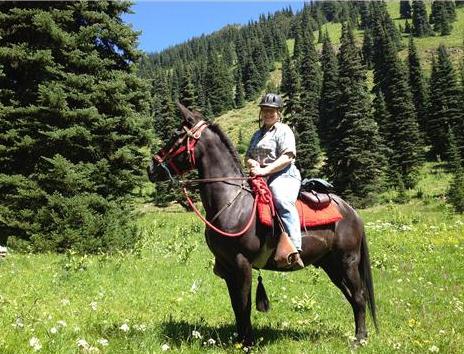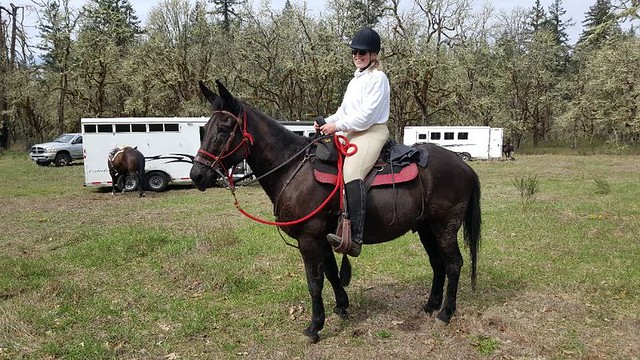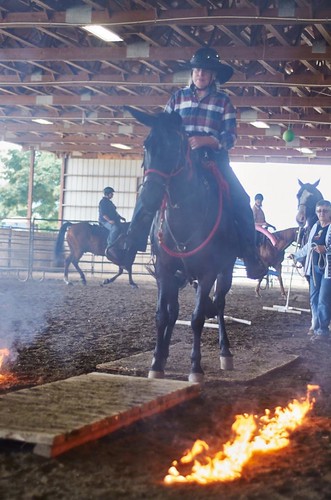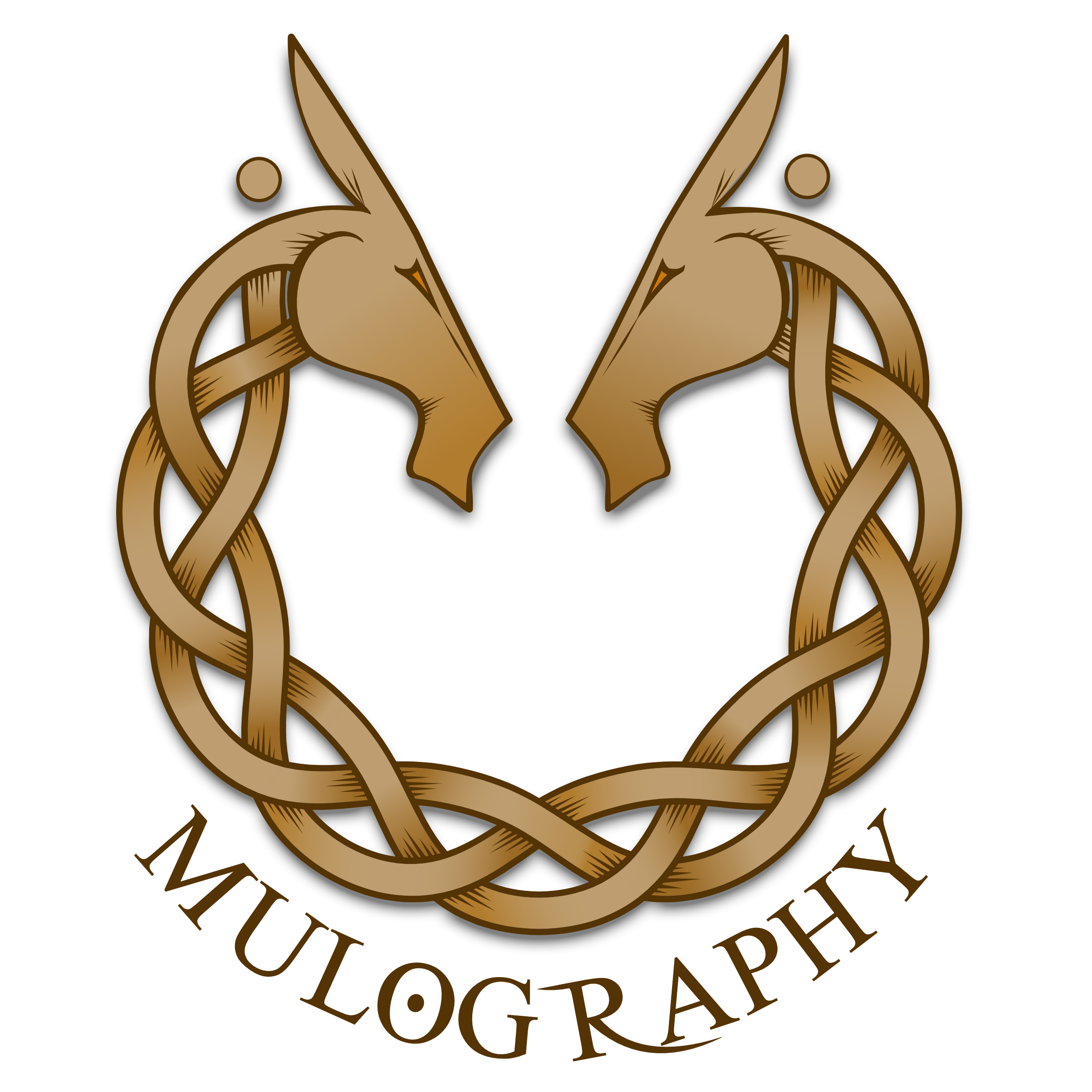In keeping with last week’s theme, we are staying in America and meeting Joan and her amazing mule, Buckshot. I saw a photo of them on a Facebook group and just had to ask for an interview – I am so glad that Joan said yes! This has been a fascinating read, and I’ve been both impressed and a little jealous of how different mule ownership is in the United States. I’m not sure how well I’d cope with bears and mountain lions, though – Marty defended his herd from a marauding moggy the other week, does that count?!
I hope you enjoy reading this as much as I did. When Marty and I grow up, we want to be just like Joan and Buckshot!
 Image © Joan Burlingame
Image © Joan Burlingame
1. Please introduce us to your mule!
My mule came to me already amazing but still a diamond in the rough. Buckshot, his name from birth 18 years ago, is a big, athletic mule. All black he stands at 15.3 hands and weighs somewhere between 1,300 and 1,500 pounds. Like me, Kenny (Buckshot’s previous owner) lives on one of the ridges near Mt. Rainier National Park. Mt. Rainier is 14,416 feet (4394 meters) above sea level. There are two reasons this is relevant. First, living on the side of a steep ridge Buckshot got very good going up and down steep slopes. The second reason is that is up in the mountains there are mountain lions, bears, big elk, and the occasional wolf pack. Buckshot, being one of the biggest mules in a herd of 12 protected the smaller mules by chasing off the mountain lions, bears, and other predators. Elk, well he just shared the pasture with elk. We live an hour outside of Seattle, Washington (USA).
 Image © Joan Burlingame
Image © Joan Burlingame
2. How did you meet him?
For the last two decades I have been active in conserving land and trails in Washington State located in the far northwestern corner of the United States. Over the years I have taken over 100 VIPs (elected officials, government managers, staff from funding agencies, and members of the press) on trail rides. I showed the VIPs land and trails that we wanted to be forever protected from development. I always needed animals for the VIPs to ride; animals that wouldn’t scare the VIPs. I partnered with an organization called Backcountry Horsemen of America. Kenny was one of the Backcountry Horsemen who volunteered the use of his mules. As I normally did, about five years ago I called Kenny and asked if I could borrow Buckshot (again) to take a VIP out for a ride. His answer was always “yes.” As he dropped Buckshot off at my place he told me that he wasn’t going to come back to pick up Buckshot. I said that was okay, I would get Buckshot back to his place. He said no, Buckshot was now going to live with me! That began my wonderful relationship with my first mule. At that time I had a Tennessee Walking horse (still do) who was already in his early 20s. As my horse got older I rode my mule more.
 Image © Joan Burlingame
Image © Joan Burlingame
3. What do you do with him, and what are your plans for the future?
Soon after getting Buckshot I decided to see what this smart, athletic mule could do. I started introducing him to one sport after another. Buckshot was already a highly experienced mountain mule; both riding and packing. First I introduced him to cattle. We began by watching horses sort and pen cattle (amateur rodeo events). The activity intrigued him and by the end of his first season we were winning a few of the events. It was amusing to pull up to a competition with an arena full of (mostly) young women on expensive quarter horses. They would look at me, an “old” lady in my 60s on a mule that out weighs their quarter horses by hundreds of pounds. They were surprised when we beat them. We have worked our way out of the “green” amateur class and now have to compete with real cowboys. We win less often but still have lots of fun.
Next I decided to redirect my mule’s strong instinct of self-preservation which is often a detriment to uneventful rides. Despooking seemed like a good idea. Buckshot and I signed up for a series of mounted patrol (police) trainings with such wild tasks as escorting a police vehicle with full sirens and lights, walking through fire on the ground, being chased by a police dog, firing a gun while mounted, and walking through smoke. We practiced being attacked by someone on the ground, me grabbing the attacker, Buckshot taking off at my command, and then my dumping the person (hard) on the ground. (I frequently ride alone in the foothills and self-defense skills are good to know.) Buckshot and I learned how to trust each other and move through many “scary” things. Twice now in the last year we have been near an ambulance as it came to help someone and Buckshot just looked at the vehicle with disinterest as it passed.
I had a couple of friends who encouraged me to try fox hunting with Buckshot. Mules generally are not used for fox hunting. They don’t “fit” the image of a hunt horse. In America many of the hunt horses are off the track thoroughbreds (OTTB) and most mules can’t keep up with OTTBs. I was intrigued with the idea. My friend suggested I read the Sister Jane murder mysteries by Rita Mae Brown. The murders all take place around fox hunting activities. Rita Mae is a Master of the Hunt herself and her books are a fun way to learn the traditions and rules of fox hunting. But I knew I had to work with Buckshot on three things before we joined the hunt: 1. His dislike for dogs (as most mules hate dogs); 2. His panic any time riders got out of line, passed us, or fell behind; and 3. His never having cantered under saddle (who needs to canter on the steep slopes of the mountains?). In the United States many mules are used as pack mules for the first few years to learn how to behave on trails. In the pack situation a mule learns to never get out of order, never canter, and to always stay together in order. That doesn’t happen on the hunt field.
The mounted patrol training and working with my own three dogs helped with the dog issue. That was an easy “fix.”
There is a sport in America called Competitive Mounted Orienteering (CMO). CMO is a cross country race lasting three to six hours. The catch is that you have to find five (short course) or ten (long course) paper plates hidden in an evergreen forest of usually at least 300 hectares in size. You are given three compass coordinates for each plate and you have to find each hidden plate using a basic trail map and an old fashioned compass. There is no set route: you decide your own route between the different plates. Horses would go every which way and at different speeds. A perfect environment to help a mule develop tolerance and flexibility. So, during the third year I owned Buckshot we started competing in CMO. I am not sure we will ever reach a national ranking … but you never know!
In 2015 Buckshot and I timidly joined the oldest hunt club in the western half of the United States. Fox hunting in my opinion is one of the hardest sports Buckshot and I could embrace. It is trail riding on steroids. At the Woodbrook Hunt Club it is a community of friendly riders who are always encouraging us to stretch ourselves and providing moral support along the way. And, amazingly enough, Buckshot is generally able to keep up with the OTTBs! To keep up with the OTTB he just decided to start cantering one day. He finally had a reason to canter. (He has a very fast trot that could keep up to most horses’ canter.) I don’t know what breed of horse he is out of but my guess would be Thorougbred. It will take Buckshot and me years to really get “good” at fox hunting but it is clearly his favorite sport and my favorite horse group.
What is next? I think that it will take us a couple of years to grow into fox hunting. I would like to have us get good enough to win some ribbons at the state level for CMO. Winning a silver buckle in amateur rodeo would be nice. And we will continue to trail ride. This summer we are riding part of the way across Washington state; a three week ~250 mile (400 kilometers) camping trip. There will be around 100 other riders going at least part of the way. It should be fun.
 Image © Joan Burlingame
Image © Joan Burlingame
4. Can you share a story that you feel sums up your mule and/or your relationship with him?
Mules are braver than horses; it is the donkey in them. For me getting home from work after dark is normal (unfortunately). One night I walked up to the barn to do chores using lights on the outside of the barn. All of a sudden Buckshot started snorting and stomping. Turning, I saw a mountain lion less than 100 feet (30 meters) from me and creeping closer. Buckshot put himself between the mountain lion and me and in no uncertain terms seemed to explain to the mountain lion what he was going to do to him (or her). The mountain lion carefully watched Buckshot for what seemed like forever (but was probably five seconds), turned slowly, and slinked off into the woods. My mule was willing to give his own life to protect mine. Buckshot and I have glided through easy things and worked our way through difficult challenges. We are a team who have learned to trust each other and work together.
 Image © Joan Burlingame
Image © Joan Burlingame
5. What’s the most important thing you’ve learnt as a mule owner, and what piece of advice would you give to someone new to mules?
Listen to your mule. And remember, mules (as all equine) tend to communicate silently. They use other means of communication such as movement patterns, head tosses, and even looking at you out of the corner of their eye. Buckshot had spent his first 17 years in a hackamore (a type of bitless bridle). I sent him to a trainer who loved mules and knew how to train them. For the most part Buckshot was an eager learner. But the trainer said Buckshot had to have a bit in his mouth because he would, at times, not stop or slow down when the rider asked. So we got him a snaffle bit. He didn’t like a bit and he ran through the snaffle just as he ran through the hackamore. I looked him in the eyes about eight weeks of riding with a bit and said to him “if you don’t run through the hackamore as much as you run through the bit I will switch back to the hackamore…” I don’t think he really understood my words but he understood my switching back to the hackamore. He is far better behaved now in the hackamore. No more bit for him.
The piece of advice I would give to a new mule owner is to take your time and let your mule grow into the skills s/he needs. You will never strong arm a mule into doing anything. Pound for pound they are stronger than horses and smarter. Give your mule time to watch; to think about something. Build one new skill each year. Many mules can be ridden into their 40s so you have lots of time to develop a strong and meaningful partnership with your long-eared friend.
Bonus! I asked Joan to tell us a little bit about how foxhunting is done in the States:
I am a member of the Woodbrook Hunt Club located south of Seattle, WA. It has been a “drag” hunt since at least 1928. The Hunt Club has used a human “runner” to drag a fox scent along the ground instead of actually hunting a fox. For quite a while (decades) Woodbrook Hunt Club was one of just a handful of hunt clubs that dragged scent to hunt. More recently using a drag has become a common method of having a scent for the hounds to follow. The hunts that do track live foxes would not consider harming a fox. In the United States hunt clubs tend to be environmentally aware. Hunt clubs work hard to protect habitat and many different kinds of species. And, not only do they not want to hurt a fox, doing so could cause them to lose their right to be a club. There is a potential that any member of the disbanded club could also be banned from being a member of any other hunt club. In the United States we are serious about not hurting foxes.
If you would like your mule to be featured here, or if you have a mule story that you would like to tell, then please contact me either via this blog, message me on my Mulography Facebook page, or email me at: herecirm (at) gmail.com. I would particularly like to hear from UK mule owners (purely because Mulography is about owning a mule in the UK), but am more than happy to take worldwide submissions!
